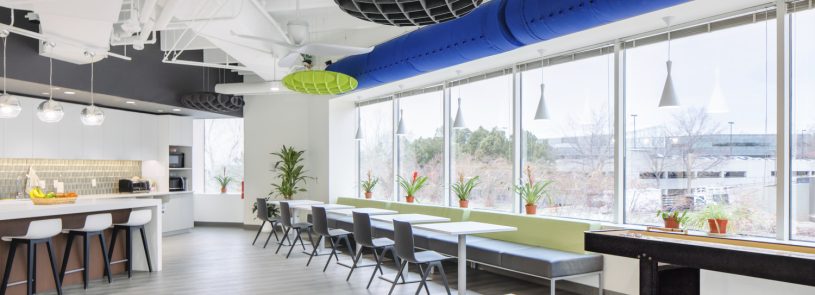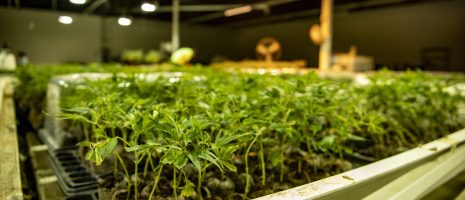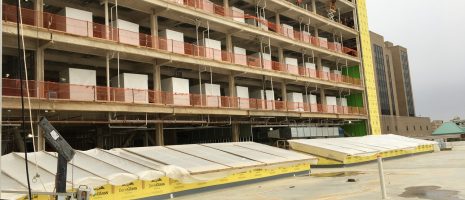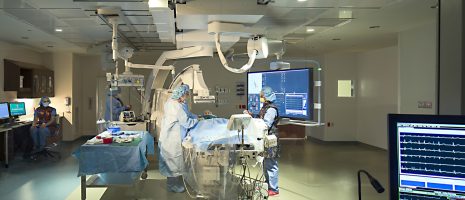IMEG Office: The design, budgeting, and value of WELL certification

IMEG is passionate about high-performance design and its ability to improve the natural and work environments while helping organizations succeed. Our WELL Building Standard Gold Certification for the renovation of our Denver office gave us the opportunity to practice what we preach.
The WELL Building Standard (WELL) is a building rating-system focused on improving the impacts of the built environment on human health and wellbeing. IMEG’s Denver office was certified under version 1 of WELL (WELL v1), which consists of over 100 features (some are preconditions to certification and others are optimizations to pursue a higher rating) organized under the standard’s seven “Concepts”: Air, Water, Nourishment, Light, Fitness, Comfort, and Mind. WELL has an advantage over many other rating systems because it is based on the actual performance of the project. Additionally, projects must be verified with onsite tests and inspections from a WELL Assessor and are required to recertify every three years to maintain certification.
Why WELL?
 When our Denver office lease renewal was approaching, we knew it was a good opportunity to rethink how our space could help us live our mission and better support our staff. It was time to convert our traditional old-school corporate office into a next-generation workplace that would foster innovation and collaboration. We decided to focus on energy performance and include energy sub-metering for our space, but we also wanted to focus on the indoor environmental quality and look for ways to optimize the office for staff health, wellbeing, comfort and performance. For this reason, we decided to pursue WELL certification for our office renovation.
When our Denver office lease renewal was approaching, we knew it was a good opportunity to rethink how our space could help us live our mission and better support our staff. It was time to convert our traditional old-school corporate office into a next-generation workplace that would foster innovation and collaboration. We decided to focus on energy performance and include energy sub-metering for our space, but we also wanted to focus on the indoor environmental quality and look for ways to optimize the office for staff health, wellbeing, comfort and performance. For this reason, we decided to pursue WELL certification for our office renovation.
The WELL Building Standard was something we were already advocating for and helping several clients pursue. It was clear we had to walk the talk and lead by example. We knew that a cost-effective, fully functioning WELL–certified office in the Denver market would be a great tool for educating clients and others in the industry. We also knew it would benefit our staff. Living in, and learning from, our own WELL office would further connect our staff with the company’s purpose. The health and well–being benefits show we care about the lives of our people, who in turn benefit the company through improved retention and recruitment. IMEG’s staff have high expectations of their own performance and value a workplace environment that intentionally promotes improved cognitive performance.
Recent research performed by Harvard, SUNY Upstate Medical University, and Syracuse University (known as “COGfx”) shows that superior air quality can, on average, double cognitive performance across many cognitive domains such as information usage, strategy, crisis response, and focused activity levels. The COGfx research concludes that improving air quality over conventional, or code level, practices can improve employee performance by 8 percent on average, resulting in a $6,500 increase in employee productivity. We have continually tracked revenue per person as a key performance indicator for our business and plan to study the long-term trend in revenue per person in the WELL-certified office versus our previous office.
Through this process, we were able to control our budget for the office renovation and show that we could achieve a WELL Gold level rating using smart design, not extra expense. Our added cost of construction and WELL certification fees increased our construction and furniture cost by $1.46 per square foot – a small premium of less than 2 percent.
Key WELL strategies
Finding the right office building: We implemented many individual strategies in our leased office space to achieve WELL certification, but one of the most important strategies was assessing potential office buildings against the WELL Standard while maintaining other priorities such as lease rate, TI allowance, location, and amenities. While we originally anticipated moving, we found that our existing building best aligned with our office criteria, including our desire for WELL certification. A few of the key WELL-related attributes of our existing office building include:
- 0.5 miles to light rail station
- On-site fitness facility, lockers, and showers
- Open, daylit stair in lobby to access our second-level space
- High-quality landscaping (including a pond), plaza space, and public art
- Quality views
- Opportunity to design our own lighting system
- Measured high air quality
- Measured low HVAC noise and exterior sound levels
- LEED v4 O+M Silver
- A building management staff (Unico) willing to work with us on WELL certification
Exceptional air quality: Outstanding air quality was a huge priority, based on the cognitive performance benefits discovered by the COGfx research. Through preliminary air testing, we knew the air quality in the building was high and that we would expect to see carbon dioxide levels in the 500 ppm to 600 ppm range most of the time. This was confirmed by ongoing monitoring, using five Awair Omni sensors (temperature, humidity, CO2, total VOCs, and PM2.5) and the dashboard installed in our space.
Our base building already had a green cleaning protocol for LEED O+M that was modified slightly to conform to WELL requirements. The base building also has healthy entrances and MERV 13 filtration on the air handling units. Our office tenant improvement work focused on VOC reduction and air quality management construction practices. We met the WELL Performance Verification air quality test threshold limits for formaldehyde, total VOC, carbon monoxide, particulate matter (both 2.5 and 10 micrometers), and ozone.
Energizing our employees with food and fitness: We also focused on energizing our employees with healthy snacks and an active workplace. This not only impacts our staff’s physical health, it is also important for high cognitive functioning. We have always had a small snack bar available for staff, but WELL gave us a robust set of guidelines to dramatically improve the quality of our snack bar offerings to include a variety of fresh, organic fruits and vegetables.
We also integrated many options into our workplace to keep our staff active throughout the day. Our building has a fitness center and we subsidize gym memberships and other fitness programs for employees. However, passive movement throughout the day is as important as regular active exercise – a concept known as NEAT (non-exercise activity thermogenesis). Increasing non-exercise activity throughout the day can lead to higher calorie conversion with loss or maintenance of weight. Our workstations incorporate sit/stand functionality, dramatically reducing sitting time over the course of the day. We also have a treadmill with a fully-functional desk with computer integration and a portable desk pedal that can be used at employees’ workstations. Our building’s open, daylit lobby staircase promotes walking to all floors of the building. Outside, walking paths and an adjacent city park provide additional exercise opportunities.

Next generation lighting: The science of our circadian rhythms, sleep cycles, hormone production, and overall health is making its way into lighting design. WELL’s circadian lighting design feature ensures that occupants have adequate exposure to the spectrum of light needed for a healthy circadian rhythm. The retinal ganglion cells in our eyes are receptors that trigger our circadian cycle. These cells are responsive to a spectrum of light, which falls in the range of short-wave blue light that is abundant in full spectrum daylight. Unfortunately, many conventional lamps used in light fixtures are deficient in this spectrum of blue light. We utilized daylighting and suspended light fixtures with a cooler color temperature 4000k LED lamp to increase the light in this blue spectrum range. Helping our staff maintain healthy sleep cycles benefits their health and allows them to bring their best selves to work every morning.
Connection to nature: The importance of biophilic design is gaining traction in the commercial real estate industry. The term “biophilia” – popularized by the American biologist E. O. Wilson – refers to humans’ innate desire to connect to nature and living systems. Exposure to nature provides many positive health and wellness benefits, including reduced stress, blood pressure, and inflammation, as well as improved memory, creativity, and cognitive function. Biophilic design seeks to reconnect people to nature within the built environment so they can gain the associated health and wellness benefits.
Quality views can create the simplest and most direct connection to nature. Our office has outstanding views of the Rocky Mountains, ample trees, an adjacent park, and a well-landscaped plaza complete with a sculpture garden. The windows also bring in dynamic and beautiful natural light, connecting us to the weather and orienting us to the time of day. Our office interior is landscaped with a variety of houseplants chosen from a list of plants studied by NASA for effectiveness in removing specific air contaminants from the environment. We also utilized an innovative planter designed to aid this contaminant removal by increasing airflow through the plants’ root systems.
Abstract connections to nature, such as the use of natural materials, colors and patterns, can also be effective. While our space is characterized by bright, light-reflecting white surfaces for the ceiling, walls and workstations, we strategically created impactful moments using natural colors, textures, and patterns.
Spearheading market adoption

Many in our industry believe they can’t afford a WELL Building certification, but we found that WELL could be achieved with a modest budget through smart planning and smart design tradeoffs. Our planning established WELL Building certification as a goal at the very beginning of our project and made WELL-specific due diligence on the building we considered for our office lease a priority. With this goal set early on, we were able to engage and integrate our project team continuously through our design, construction, and operation of the space. Our project team included Unico (building manager), Stantec (architect), and BOOTS (contractor). We self-performed MEP engineering and WELL consulting services.
Adding value through high-performance design is often accomplished by using strategic design tradeoffs to maintain the budget and project performance. This strategy was key for us to achieve WELL Building certification within our modest budget. Perhaps the most important design tradeoff made was to reduce the overall area of our office. Our previous workplace was dominated by large cubicles, with limited collaboration spaces and work amenities. Basically, it was the workplace equivalent of urban sprawl. For the renovation, we created smaller – but better – workstations and invested in a range of spaces, such as team breakout spaces, huddle rooms, conference rooms of different capacities, and wellness rooms. We reduced the size of our office by about 25 percent – but dramatically increased the quality of our workplace. Other smart tradeoffs included reusing ceiling and carpet tiles by integrating them into the overall design concept of the space. This sustainable use of material resources allowed us to invest not only in WELL features, but also better technology and workplace amenities.
Tremendous value added
The design, construction and operation of the work environment is an often-untapped opportunity for organizations to invest in advancing its mission of sustainability. An organization’s people are central to fulfilling its mission and ongoing operational cost. However, much of today’s existing and new commercial office space gives little thought to how the physical work environment can impact people’s physical and emotional health and cognitive performance. Our built environments are not neutral; they have the potential to degrade human comfort, health and performance, but, if they are thoughtfully designed, they can enhance employee wellbeing and productivity.
Our office remodel experience has convinced us that pursuing WELL certification can add tremendous value to an organization by investing in its staff, and that through smart planning and design, it can be done without a significant cost premium.













